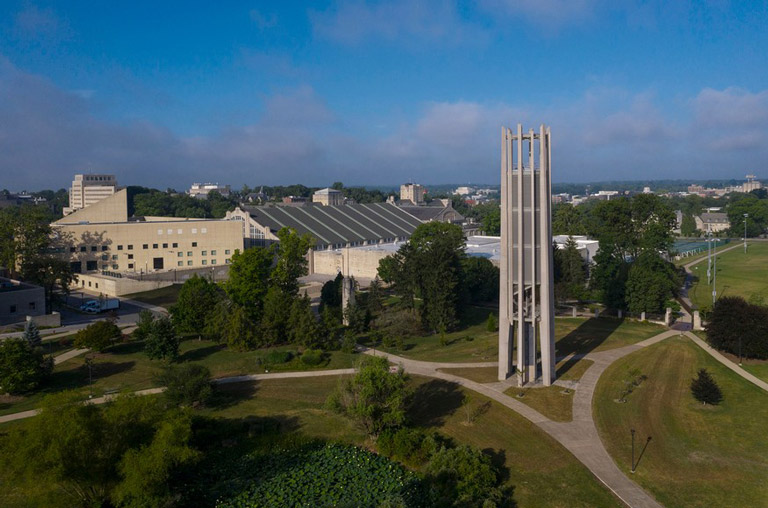Not only will you not find “carillon” in any edition of architectural graphic standards, it’s pretty hard to find an architect who’s designed one; there are just over 600 in the world, and most aren’t very new. So when New York–based architect Susan Rodriguez, FAIA, received a call from Indiana University’s president saying, “I have a great opportunity for your new studio,” she didn’t necessarily know what to expect when he told her the project was for a carillon to commemorate IU’s bicentennial in 2020.
Rodriguez had worked with the university for nearly 15 years when she was a partner at Ennead, first on the Global and International Studies Building, and then on the renovation of I.M. Pei’s Eskenazi Museum of Art. Both buildings face the campus arboretum—a leafy landscaped preserve that replaced the school’s old stadium in 1980, and that now has a new centerpiece with the Rodriguez-designed bell tower.
The 61-bell carillon was initially installed in a Brutalist, cast-in-place concrete enclosure to celebrate the university’s sesquicentennial in 1970. Fifty years later, the new tower sees the addition of four bells that extend the instrument’s musical range and give it standing as a grand carillon—one of fewer than 30 in the world.
Many carillons are housed in opaque towers or attached to buildings. “I felt it was important to make it open so that you can move under and through it,” Rodriguez says. "But how do you support 88,000 pounds of bells?”
Rodriguez worked with Dan Sesil and Pat Hopple from LERA Consulting Structural Engineers on developing a radial structure that would support the instrument’s heft and allow its sound to project across the campus. But determining the height of the structure required a bit of Goldilocks-like collaboration. If the carillon is too low, the sound is confined to a limited area; too high, and the sound dissipates. “We worked with carillonneur John Gouwens and the bell fabricator [Netherlands-based Royal Eijsbouts] to define the ideal,” she says.
The solution employs six 128-foot-tall limestone piers that support six radial steel hubs braced by six vertical precast concrete fins. An acoustical louver system shields the bells while allowing their music through. The structure’s monochromatic hue is based on the Indiana limestone that clads its piers, the famed masonry that is locally quarried and used on many of the campus’s buildings.
The instrument is played from a console chamber that sits at the base of the enclosed section of the tower, which doubles as a microclassroom that allows the carillon to be used for small-scale instruction.
Each bell has a quote about music from an English or American author. “We were fascinated that the [old] bells were inscribed with quotes,” Rodriguez says. But when she and her studio read them carefully, they realized that the 61 inscriptions were all from men. “We pointed that out and I said, ‘Well, that has to change,’ ” Rodriguez says. “They were excited to select four women to add.” The four new bells are inscribed with quotes from Maya Angelou, Emily Dickinson, Hildegard of Bingen, and Sappho. “It’s a subtle subtext that’s wonderful and speaks to the leadership of the university,” she says. Which sounds like something worth ringing a bell (or 65) about.
Read the article on Architect

